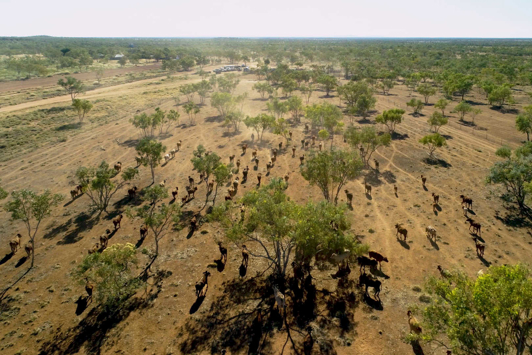What is the Pastoral Remote Sensing app?
The Pastoral Remote Sensing (PRS) application provides mapping tools and estimates of cumulative rainfall, total green biomass, total dry matter and normalised difference vegetation index (NDVI) for every pastoral lease in Western Australia (WA).
The department, in partnership with Landgate, developed the app to assist pastoral land managers. By using the app, managers can make more-informed management decisions to improve the profitability and sustainable use of pastoral resources.
The app offers information on seasonal condition and trends, including:
Monthly ground cover data is presented for the station's land systems as estimated bare earth %, dry vegetation %, green vegetation %, total vegetation % and satellite imagery for a chosen month of a chosen year.
The land systems are in a table on the left-hand side when this option is chosen, with the percentages and an icon leading to charts of the estimated monthly ground cover data:
- bare earth %
- dry vegetation %
- green vegetation %
- total vegetation % cover.
Weekly data is presented for the station's land systems as mapped normalised difference vegetation index (NDVI or greenness index) categories for the station land systems, NDVI satellite imagery for the region, and estimated total green biomass (TGB).
The land systems are in a table on the left-hand side when this option is chosen, with the TGB for the period chosen, and the change since the previous week.
There is an icon leading to charts of the estimated weekly values:
- total green biomass
- NDVI
- total dry matter; rainfall.
High resolution imagery is presented for a given fortnight and year. The map fills the screen and show the chosen station centred in the region. The image is of either NDVI values, or the estimated total green biomass (TGB). This image has 10 x 10 metre pixels
Note: This information is estimated, and should not be the only source of information for management decisions.
Use Pastoral Remote Sensing application online
Pastoralists can use the modelled information to guide management decisions and on-ground monitoring and measurement.
Read the information on this page before using the app for the first time.
How to use the app:
Most of the information in Pastoral Remote Sensing is estimated using modelling and not based on data collected at regular intervals on each station.
This means the information is a guide only, and you should not treat the values provided as real or base management decisions only on the information in Pastoral Remote Sensing. However, you can use the information to guide your lease-level decisions by putting current seasonal conditions into perspective.
PRS Online tutorials
The following 11 videos explain each section and use of the app. Users are encouraged to view there before using the app for the first time.
Interpreting the information
For information on the terms used, see the FAQs below or within the PRS app.
-
Pastoral Remote Sensing FAQspdf (220 KB)
What is Normalised differential vegetation index (NDVI)?
Normalised difference vegetation index (NDVI) is an index of greenness seen by satellite and is an indication of the amount of green vegetation. Much of the information in the app is based on the NDVI values and modelling of plant growth, which is why the NDVI values and trends are so important.
About NDVI
NDVI:
- provides an estimate of green vegetation density and health at the time of the satellite run. That is, the green the satellite 'sees', the higher the value.
- can be used with or without ground measurement to estimate the following factors:
- green biomass*
- growing season relative value
- fractional vegetation cover
- leaf area index.
- can be used to show the effects of management and season on vegetation growth.
NDVI does not:
- estimate feed on offer (FOO) but is correlated with green biomass.
- register dry biomass.
- differentiate between annual or perennial plant growth, or desirable and undesirable green plants.
- indicate pasture condition (mostly because of the points above).
*For an accurate estimation of green biomass, NDVI values need to be calibrated with weighed biomass cuts from the target paddock.
Download PRS Station Reports
If you have restricted bandwidth and cannot easily view the full Pastoral Remote Sensing app, you can download a summary of the PRS information, provided in a pdf document.
Go to Station Reports
